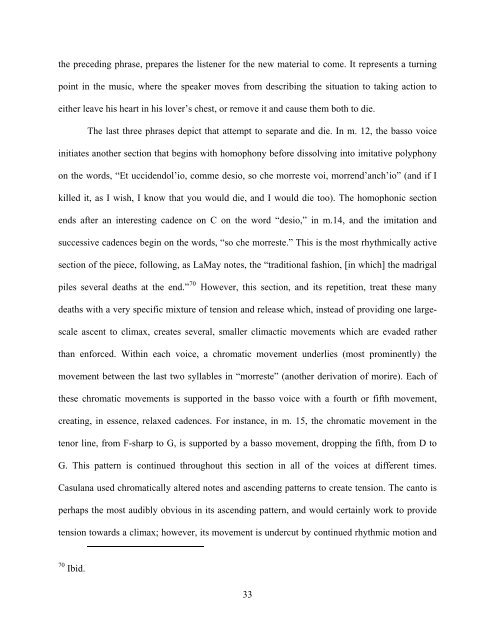Download - D-Scholarship@Pitt - University of Pittsburgh
Download - D-Scholarship@Pitt - University of Pittsburgh
Download - D-Scholarship@Pitt - University of Pittsburgh
You also want an ePaper? Increase the reach of your titles
YUMPU automatically turns print PDFs into web optimized ePapers that Google loves.
the preceding phrase, prepares the listener for the new material to come. It represents a turning<br />
point in the music, where the speaker moves from describing the situation to taking action to<br />
either leave his heart in his lover’s chest, or remove it and cause them both to die.<br />
The last three phrases depict that attempt to separate and die. In m. 12, the basso voice<br />
initiates another section that begins with homophony before dissolving into imitative polyphony<br />
on the words, “Et uccidendol’io, comme desio, so che morreste voi, morrend’anch’io” (and if I<br />
killed it, as I wish, I know that you would die, and I would die too). The homophonic section<br />
ends after an interesting cadence on C on the word “desio,” in m.14, and the imitation and<br />
successive cadences begin on the words, “so che morreste.” This is the most rhythmically active<br />
section <strong>of</strong> the piece, following, as LaMay notes, the “traditional fashion, [in which] the madrigal<br />
piles several deaths at the end.” 70 However, this section, and its repetition, treat these many<br />
deaths with a very specific mixture <strong>of</strong> tension and release which, instead <strong>of</strong> providing one large-<br />
scale ascent to climax, creates several, smaller climactic movements which are evaded rather<br />
than enforced. Within each voice, a chromatic movement underlies (most prominently) the<br />
movement between the last two syllables in “morreste” (another derivation <strong>of</strong> morire). Each <strong>of</strong><br />
these chromatic movements is supported in the basso voice with a fourth or fifth movement,<br />
creating, in essence, relaxed cadences. For instance, in m. 15, the chromatic movement in the<br />
tenor line, from F-sharp to G, is supported by a basso movement, dropping the fifth, from D to<br />
G. This pattern is continued throughout this section in all <strong>of</strong> the voices at different times.<br />
Casulana used chromatically altered notes and ascending patterns to create tension. The canto is<br />
perhaps the most audibly obvious in its ascending pattern, and would certainly work to provide<br />
tension towards a climax; however, its movement is undercut by continued rhythmic motion and<br />
70 Ibid.<br />
33















